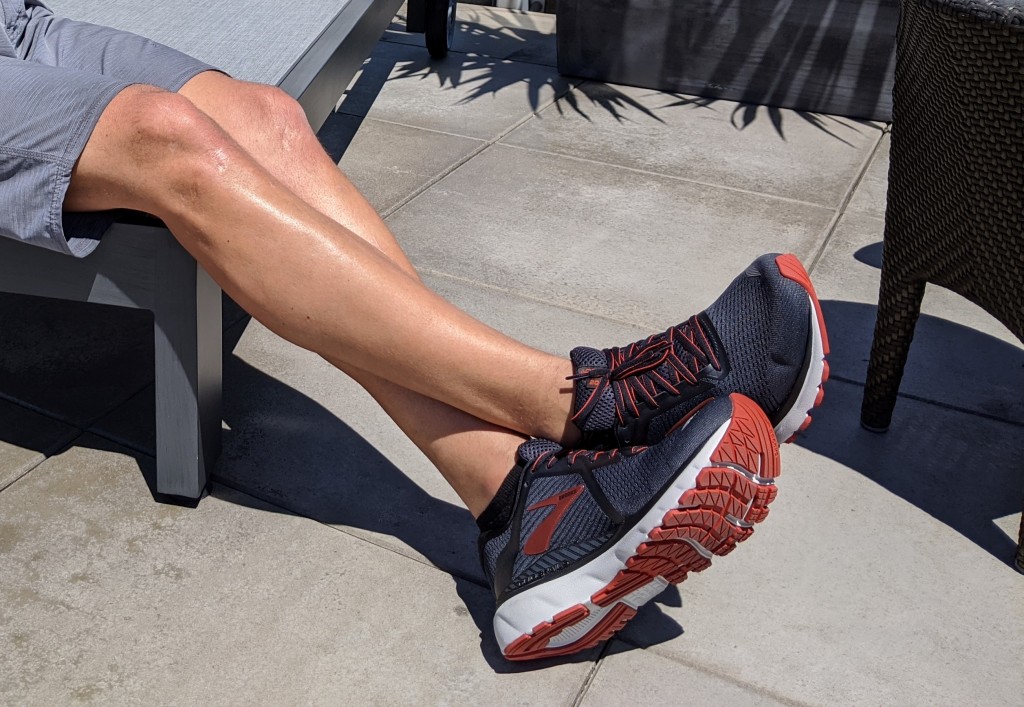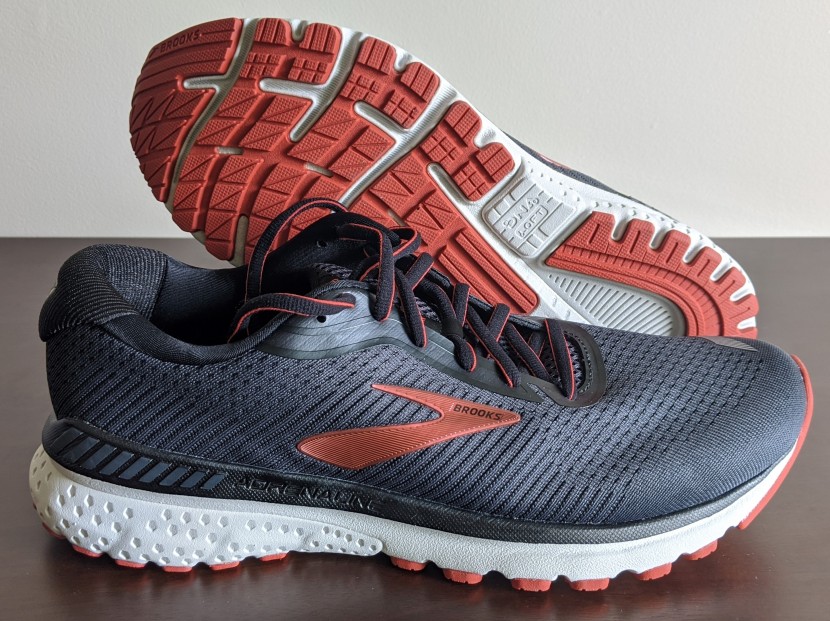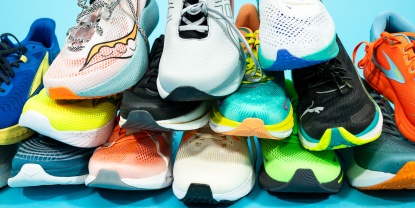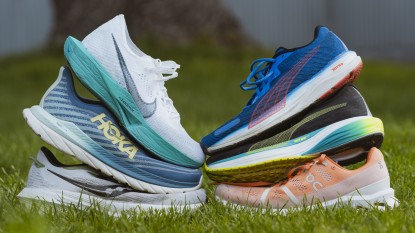Brooks Adrenaline GTS 20 Review
Our Verdict
Our Analysis and Test Results
To get to the current badassness of the GTS 20, Brooks preserved the baseline Adrenaline model and added a few new features. Among them are a refined upper mesh for a nicer fit and reduced weight. They also changed up the GuideRail support for a more natural ride.
Performance Comparison
Responsiveness
The Adrenaline GTS 20 is one of the more responsive models in our lineup. The way it gets to that responsiveness is a major contributing factor to its winning of our Top Pick for Comfort Award. While it has some kick to it, there's not a lot of fighting against the shoe for good foot placement. There's no penalty in flexibility. You can actually take this shoe to the gym and do sprints and lunges.
The GTS 20 arrives at its responsiveness by hitting the two big areas: the makeup of the midsole material and its design. As in its predecessor, the midsole is comprised of BioMoGo DNA, while the crashpad is made up of DNA LOFT. The crashpad at the heel is softer than the rest of the shoe to help blunt your landing. As a side note, the sweet thing about BioMoGo DNA is that it's not just an excellent, bouncy midsole material, but, as the name should hint to you, it's significantly more environmentally friendly than standard foams. It breaks down something like twenty times as fast. How's that for CSR? The sole balances cushiness and kickback with flexibility. That's one of the major reasons it works so well as a comfort model. It has the stability and response, but it's not like running on a bouncy board.
Now design: Brooks has started using its GuideRails Holistic Support System in a lot of its running shoes, including the GTS 20. The idea is that there's a natural gait runners have, and the GuideRails help steer them into it. Brooks describe it something like a bobsled careening down… whatever it is that's considered the bobsled's natural habitat. Let's call it a track and hope that's accurate. The fastest bobsleds are the ones that best slip down the grooves worn into the track with minimal lateral movement and chaotic noise. On the shoes, the GuideRails work like that. They aren't meant to correct your gait, but they help limit the movement that could slow you down and damage your connective tissues from misaligned percussion.
And it works! We found in our running that the shoes weren't too forceful in their gait assistance, allowing us to have a more natural experience while gently ushering us into form. Of course, the shoe also has a serious heel counter with a little bit of sculpting in the footbed to help re-establish a natural foot position. The effect is quite a nice comfort model with some serious kickback.
Landing Comfort
Landing comfort will track responsiveness in some ways. And where it doesn't track responsiveness, it's often an inverse relationship. What we mean by that is that the things that make a shoe responsive often reduce the comfort. Conversely, the things that blunt the impact of slamming your foot into the ground tend to take away from the energy that's put back into the ground and converted into propulsion.
The Adrenaline GTS 20 gets to this in much the same way it does the responsiveness. The midsole is made of two fluffy materials with slightly different densities and performance profiles. It allows landing to be forgiving without sacrificing too much as the gait transitions force and weight into the midfoot and into toe-off. The effect is quite good. You still feel fast without aching joints by the end of a longer run.
The GuideRails also contribute here. A lot of models tend to use stability features that will force your landing with counters and internal structures meant to coerce your foot into a neutral position. The GuideRails are more suggestive ushers that help you get into a more natural position. Helpfully, the sole is also extremely flexible. Sure, this takes away from the responsiveness (read: rigidity) of the sole, but you spend a lot less time and morale fighting with the shoe to get into a good flow.
Of course, a lot goes into making the upper nice and supple, and that directly translates into landing comfort. That can be seen in the heel, collar, and tongue, where padding is in no short supply. At the heel, it's a dense mat that tapers off as it wraps around the collar to the top of the foot. The tongue's padding is thick, but more of a light foam to dampen the road noise bumping through the top of the foot and ankle.
Perhaps the only problem we could find here dealt with just how thick the heel stack is. It does a great job of cushioning impact, but it's also 12mm thicker than the toe. That's suitable to a lot of runners' gaits, but even the best-adapted runner might find that their heel starts to catch the ground when their strong, robust, powerful strides become turkey-trot shuffles by the end of a long, hard run. It's obviously not a deal-breaker, but it's a consideration for those of us with that pernicious habit of dragging ass for the last, let's say 40%, of literally any workout.
Weight
The GTS 20 is not the lightest shoe on the market, for sure, but it's an improvement over the earlier version, shedding about an ounce out of a pair of men's 11. It comes in at just under 23.1 ounces for the pair.
It looks like the primary contributor to the reduced weight is the refined upper. The new material is an engineered mesh with 3D print overlays that minimizes the superfluous filigree and other stuff that no one especially appreciated, bringing the weight down just a bit more and keeping the visual appeal a little more straight forward.
Durability
This is an area where these sorts of shoes tend to excel. Stability models need to be tough to do their job through all the abuse they're put through. Comfort shoes need to maintain their cushion for long enough not to piss people off. The Adrenaline GTS 20 mostly stands up to that.
The overall construction has no real problems. The threading is fine. The new engineered mesh with its 3D print holds up. There are really no complaints about the upper. Even the heel counter holds up. The outsole is also well covered by a thick layer of rubber that covers almost the entire region, conferring more than adequate protection.
But there are some concerns about the midsole's performance over the long term. While its density differential allows it to straddle pop and squish, it might not last. We found a few reports that the pop fades. We weren't able to replicate it, but it's not unthinkable. Many light, springy foams do tend to compress over time. Just understand that if you're looking to get into the Adrenaline GTS 20 or any big comfort model, you might get some foam compression over time.
Upper Comfort
This is really where the GTS 20 earns its keep and wins our heart(s). It's why we gave the shoe our Top Pick for Comfort Award. It's a finessed balance of cushion and fit. Everything from the snugness to the molding in the footbed make it one of the best running shoes on the market.
The heel cup and collar padding also work quite well together to gently clasp around the heel and ankle, so the shoe adheres really well. There's very little slippage, and most runners will never have to worry about anything approaching a blister. That's not just because of the dense padding cushioning your bits — it's because of good design.
We were surprised to find reports that runners had to tie the shoes down pretty tight to get the heel to stick. We didn't have that experience at all, but it's certainly something floating around out there, so it's possible that you might have the sort of foot that won't catch in the cup. If that is you, there's a little consolation in the tongue. It's stuffed with a light foam that compresses for a natural fit, so it's flush with the rest of the upper and won't disproportionately press down into the top of your foot.
The sockliner is designed for reducing friction, and it executes on that really well. Once you've slipped your foot in and get to feeling around a little, you'll probably notice the 3D print saddle that helps the shoe wrap around your foot and gently center on your heel and the arch of your foot to reduce excess movement.
It's really noticeable when you're doing speedwork or cross-training. The shoe, though big, feels less like a clunky comfort model and more like a speedy racing flat. It has excellent adherence to the foot without crowding. We're not saying that you won't still notice that there's a pillow appended to the business end of your leg, but it's one of the best pillows to have placed there if you're into the pleasurable running experience thing. Among the big comfy models, it feels the most like a proper racing shoe.
Breathability
Like most comfort models, the Adrenaline GTS 20 isn't quite there. It does what it can to cool things down. Still, it's much better in cool weather than hot. If you do end up in them during the summer months, try to run in the coolest parts of the day and wear lighter socks.
The new upper uses a 3D print with just a bit of overlay. The material is reasonably tough, yet remains fairly permeable. When you're out on the road, you'll definitely catch a breeze in through the top of the toes, but that real estate is limited. The very front of the shoe has a small bit of reinforcement. It's possible that it might block exterior moisture from getting into the shoe, but it's most likely to help the toebox keep its shape and possibly as a bit of fortification. But for the purposes of this section, it's notably effective in retaining moisture while insulating. That's great for cool weather, less so in hot, muggy conditions.
As helpful as the new upper is, there's not a ton that can be done with the padding. It's always going to be hot and retain moisture when it's as robust as it is. And it's going to remain that way so long as Brooks wants to put out a big comfort model. If you want a cooler shoe, you won't get all that pillowy goodness encasing your foot from the heel, around the collar, and along the top of your foot embedded in the tongue. The tradeoff can be tough if you do most of your running in hot weather, but if you can run in cooler parts of the day, it should be easier to make that call.
Value
These come in at something of a premium. It's about what you can expect to pay for any comfort or stability running shoe, and, as such, it's a fair ask. We don't think you'll have much luck finding a better comfort shoe for this price. Of course, we wouldn't be sad to see the price come down a little.
Conclusion
The Brooks Adrenaline GTS 20 is the continuation of a great line. It wins our Top Pick for Comfort with its improved flexibility and upper fit joined by the baseline padding and stable snugness. But what gets us isn't that it's just filled with pillowy goodness or underfoot cushion. It's that it feels fast as hell. You get a lot of return out of the shoe. You're not bogged down, running against a marshmallowy sole. You can get after PRs in the GTS 20 without fighting to get momentum. And its stable fit gives you the footing you need for speedwork and explosiveness, making it a good option for cross-training and gym work. We don't typically find that in either comfort shoes or stability shoes. That's because its stability features, while effective, aren't overpowering or so rigid that they make you clumsy when you try to twist, flex, or pivot. If you're looking for an elegantly designed running shoe with excellent comfort that doesn't compromise performance, give this one a serious look.














